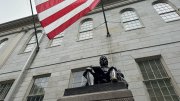The Harvard Corporation has accepted a recommendation not to dename the Arthur M. Sackler Museum and Building, the University announced today. The denaming request was originally submitted in October 2022 by a group of students who argued that Arthur Sackler’s association with, and indirect responsibility for, the opioid crisis warranted denaming. A committee tasked with examining the request was “not persuaded” by the request’s arguments, their report says, and recommended against denaming. The Harvard Corporation accepted the recommendation in July.
The decision marks the first time the University’s new process for considering denaming proposals has played out in full. The procedure was laid out in December 2021 by a committee charged with articulating principles for denaming, chaired by president emerita Drew Gilpin Faust and formed by President Lawrence S. Bacow in October 2020. A review process considering a request to dename Winthrop House is ongoing.
In 1952, Arthur Sackler cofounded, with his two brothers, the pharmaceutical company that would become Purdue Pharma. That company aggressively marketed the opioid painkiller OxyContin, contributing to the opioid epidemic that has led to more than 645,000 overdose deaths. Though Arthur Sackler died nine years before the introduction of OxyContin, the students’ request provided several arguments for denaming anyway: that Sackler created the aggressive marketing strategies that were later used to promote OxyContin, that the Sackler name is associated with the opioid crisis regardless of Arthur Sackler’s individual actions, and that he committed unethical conduct separately from the opioid crisis.
In considering these arguments, the committee followed principles stated in the University’s process for handling denaming requests, including that the process be guided by “careful deliberation and investigation” and “discussion that is robust, respectful, and generous.” Those principles also state that the recommendation should be made based on the strength of the submission, not the number of people who supported denaming or the “strength of their convictions.” A denaming request is stronger, the denaming report says, when it satisfies certain conditions: the name creates a “harmful environment” for University affiliates, the namesake’s “morally repugnant” behaviors are a “significant component” of their life, the entity in question is “central to University life,” and the namesake’s “abhorrent” actions would have been seen as such during their lifetime.
The review committee evaluated each of the students’ three arguments and found that they did not meet the conditions established in the denaming report. The report’s first argument was that Arthur Sackler played a role in developing the aggressive marketing practices that Purdue Pharma later used to advertise OxyContin. To this claim, the committee wrote that there is no evidence that Sackler himself would have used those methods to promote OxyContin. The committee, the report says, “was not prepared to accept the general principle that an innovator is necessarily culpable when their innovation…is later misused by others.” Second, the students argued that the Sackler name’s association with the opioid crisis warrants denaming regardless of Arthur Sackler’s individual actions. To this, the committee wrote that “individuals should be judged by their own actions, inactions, and words.” Finally, the students claimed that Arthur Sackler committed unethical actions separately from the opioid crisis—in particular, that he participated in scandals involving fictitious doctor testimonials and bribes. The committee found that “the evidence is not conclusive” as to whether Sackler was involved with these scandals.
The committee emphasized that the recommendation is not “an exoneration of Arthur Sackler or an endorsement of his actions.” It also recommended that an effort be made to communicate Arthur Sackler’s legacy on the museum’s website and within the museum and building.









